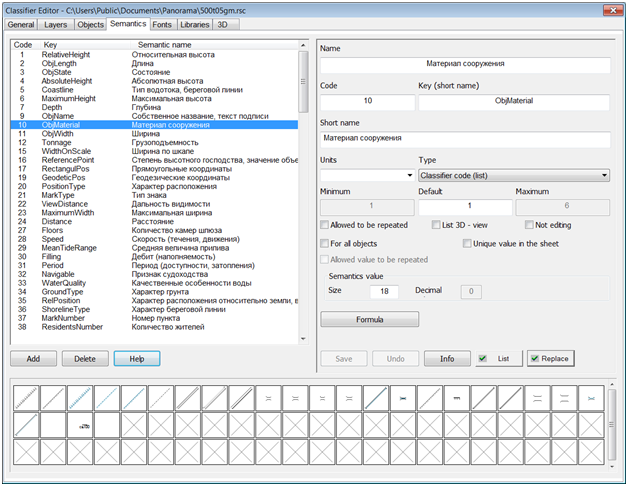Editing of semantics fields |


|
|
In the right part of Editing of semantics dialog the fields with semantic characteristics are submitted. The name of semantics (31 symbol) is an any character string. Code of semantics (the integer is less 65000) serves for identification and should be unique. The key of semantics (string up to 15 symbols) is used for the name of fields in databases (it is supposed to include symbols, possible for the name of fields in bases). The key can serve for identification and should be unique. For all SQL databases it is forbidden to name fields (and hence to give a short name to semantics) from the following list of forbidden words: 'AND', 'BY', 'CHECK', 'COMMENT', 'CONTINUE', 'CURSOR', 'DBSPASE', 'DEFAULT', 'DOUBLE', 'EXEC', 'FOR', 'FOUND', 'GRANT', 'IN', 'INT', 'KEY', 'MAX', 'NOT', 'ON', 'ORDER', 'PRIMARY', 'REAL', 'ROLLBACK', 'SET', 'SQL', 'SQLCODE', 'SYNONYM', 'UNIQUE', 'VARCHAR', 'WITH', 'ADD', 'ANY', 'CATALOG', 'CLOSE', 'COMMIT', 'COUNT', 'DATABASE', 'DEC', 'DELETE', 'DROP', 'EXISTS', 'FOREIGM', 'FROM', 'GROUP', 'INDEX', 'INTEGER', 'LANGUAGE', 'MIN', 'NULL', 'OPEN', 'PASCAL', 'SCHEME', 'SMALLINT', 'SQLERROR', 'TABLE', 'TO', 'UPDATE', 'VIEW', 'WORK', 'ALL', 'BETWEEN', 'CHAR', 'COBOL', 'COMPUTE' ,'CREATE', 'DATE', 'DECIMAL', 'DESC', 'END', 'FETCH', 'FORMAT', 'GO', 'HAVING', 'INTO', 'LIKE', 'MODIFY', 'NUMERIC', 'OPTION', 'PLI', 'SECTION', 'SOME', 'TTITLE' ,'USER', 'ALTER', 'AUDIT', 'BTITLE', 'COLUMN', 'CONNECT', 'CURRENT', 'DBA', 'DECLARE', 'DISTINT', 'ESCAPE', 'FLOAT', 'FORTRAN', 'GOTO', 'INSERT', 'IS', 'LONG', 'MODULE', 'OF', 'OR', 'PUBLIC', 'SELECT', 'SQL', 'SUM', 'TIME', 'UNION', 'VALUES', 'WHERE', 'YEAR'.
Units of measurements are used for titles of semantics values. If semantics has no measurement (for example State) the field should be empty. For choice of measurements units you must choose necessary value from the standard list or input necessary unit from the keyboard. Semantics values can be different type: character string (string up to 256 symbols), numeric value, classifier code, pointer to object and name of file (various type, for example, PCX or BMP). If semantics has Classifier code type, it means that semantics values are integers to which character values are attributed. For semantics having Numeric value or Classifier code type the default values must be entered. These default values are common for all objects. If semantics is mandatory for object, and value for any reason is absent, the default value will be given to object semantics. When you input the values of objects semantics the interval of possible values is established by minimum and a maximum of default value. For values of classifier code type the minimum and a maximum is established automatically. The user can enter only default value. For assigning 3D images, semantics are used with values such as code from the classifier with the predefined names. Such semantics are created and edited only from dialog of Editing 3D image. The name of this semantics consists of a user name, to which the "# P3D #" line and the file name of 3D image are connected, for example "Building types#P3D#topo100.p3D". If you assign this semantics to an object, then the 3D view of the object will be determined by the values of the classifier of the given semantics. Not editing field is used when the object's semantics is created automatically and are not subject to correction by the user. Size and decimal places of semantics field serve for the formatted output of semantics values and unloading into a database. Allowed to be repeated field is used when the object can have some values of semantics. For example, kind of vegetation semantics for object "forest" can have values: a pine, a birch. The field Allowed value to be repeated is used in cases when an object can have several values of the semantics of the same semantics and these values can be repeated. For all objects field allows to use semantics for any object of the classifier, not appointing its to each object. Editing of semantics provides for values input into these fields. Info button serves for showing statistics on use of semantics. For some semantics, values can be calculated using the specified formulas. The Formula button is used to assign and edit the formula assigned to the selected semantics. To delete a formula, change the type of semantics onto numeric or symbolical one. To assign a template of character semantics, use the Template button.
The Replace button is intended for setting up automatic recoding of semantics of the "Classifier code (list)" type when updating the classifier. This allows you to automate the process of replacing the reference (a list of values and their codes) and rebuilding a series of objects created on the basis of the replaced semantics. Instead of introducing a new version of the classifier (RSC), a new semantics with a new list is added into the existing one. In its description the possible source of values is indicated by recoding the reference by coincidence of the Key field or a field with the Short name. Series of objects are updated according to the values of new classifiers of semantics. When the user replaces the old classifier in the folder with the map and opens the map, objects will be automatically recoded with the formation of new semantics that have values from the new value classifiers. Objects will be displayed with new conventional symbols. When replacing it with the old classifier, the conventional symbols will return to their previous form.
If semantics is used for a series of objects such semantics is not deleted. Use Save button to save semantics values.
In the classifier editor, in the "Semantics" bookmark on the panel of properties, the "Round up" field has been added. When requesting a value of numeric semantics when displaying labels and values in various dialogs, the value is rounded to the number of digits specified in the Decimal point field in the Classifier Editor. For example, if the semantics stores the value 17.132, then 17.13 would be displayed for a precision of 2 digits. If the property "Round up" is enabled, then 17.14 will be displayed. |

